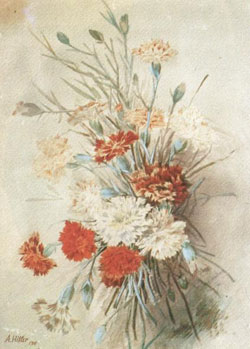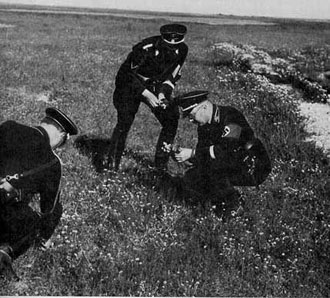Human Flower Project
Friday, January 27, 2006
Nazis & Flowers
“Do you really want to be sent to your death by a perfect gentleman?”

At Sachsenhausen, site of a Nazi concentration camp
International Holocaust Remembrance Day
Jan. 27, 2006, Oranienburg, Germany
Photo: Sven Kaestner, for AP
In observance of the first International Holocaust Remembrance Day, a memorial designated by the United Nations, wreaths and roses pay tribute to those killed by the Third Reich.
“Soviet troops liberated Auschwitz and the neighbouring Birkenau camp on Jan. 27, 1945. Some 1.5 million people, most of them Jews, died there from gassing, starvation, exhaustion, beatings and disease. Other victims included Soviet prisoners of war, Poles, Gypsies, homosexuals and political opponents of the Nazis.”
No one knows how many people were murdered in the Nazi camps. Historians estimate that at least 6 million Jews and 4 million others died, most of them systematically murdered in mass gas chambers.
But the honorific tributes laid at monuments across the world must not obscure other floral memorials due today. These were flowers of deceit, of forgetting, Human Flower Projects dedicated to inhumanity.
 Dianthus, by Adolph Hitler
Dianthus, by Adolph Hitler
Photo: Hitler Historical Museum
We learn that at the Nazi camp in Dachau, where prisoners were mutilated with medical experiments, there was also a flower garden. Other gardens were planted in the ghetto of Theresienstadt, Czechoslovakia, making it a temporary showplace for investigators from the American Red Cross, before “the Jewish ‘actors’ were shipped to their death at Auschwitz.”
Hitler himself was a painter, quite sensitive in his still lifes of flowers.
Here is an excerpt from the letter 1st Lieutenant William Cowling, a young American soldier who took part in the liberation of Dachau, wrote home to his parents:
“The first thing we came to were piles and piles of clothing, shoes, pants, shirts, coats, etc. Then we went into a room with a table with flowers on it and some soap and towels. Another door with the word ‘showers’ lead off of this and upon going through this room it appeared to be a shower room but instead of water, gas came out and in two minutes the people were dead. Next we went next door to four large ovens where they cremated the dead. Then we were taken to piles of dead. There were from two to fifty people in a pile all naked, starved and dead. There must have been about 1,000 dead in all.”
And here are the flowers Alice Lok Cahana remembered. Her story is related in Laurence Rees’s book, AUSCHWITZ: A New History, reviewed by David Von Drehle for the Washington Post.
“We find workers at Auschwitz, on Oct. 7, 1944, coaxing the shivering, hungry children from Barrack 8 in the Birkenau annex with a promise of warm winter clothes. Alice Lok Cahana, 15, hoped to scrounge a few garments for her sickly sister, Edith. The children were led to a brick building in a corner of the compound and told to strip off their rags.
“Alice did not panic, and the reason is quite horrible. She noticed ‘flowers in a window’ of the building she was about to enter—which was, of course, a gas chamber. Flowers made her think of her mother, who loved violets, and so she felt calm.”
 Heinrich Himmler picks flowers at the herb farm outside Dachau
Heinrich Himmler picks flowers at the herb farm outside Dachau
Photo: Dachau scrapbook
Just five years ago Rabbi Josef Polak returned for the first time to Westerbork, the transit camp in Holland where he and his parents waited to be sent to Bergen-Belsen. Polak said it had been “the craziest place on the planet,” the imprisoned Jews there dressing up in coats and ties, lost in a dream of normalcy even as each Tuesday another 2000 people would be marched off to a train, to die.
“By every available account, SS Obersturmbannfuhrer Albert Gemmeker—the man who ensured the weekly flow of thousands of Jews from the Westerbork transit camp in Holland to the death and labor camps in eastern Europe—was a perfect gentleman. But as Rabbi Joseph Polak asked…, ‘Do you really want to be sent to your death by a perfect gentleman?’”
Westerbork’s buildings were destroyed in 1971. “The craziest place on the planet” is now a field of flowers.
Culture & Society • Gardening & Landscape • Politics • Secular Customs • Permalink




